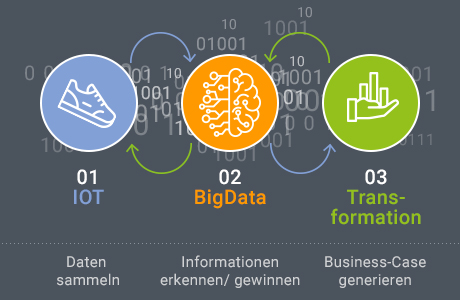From digitalisation to transformation - a definition

The three phases of transformation and what we can learn from the "Shruggie"
We, from think tank, were there; at the second Munich Digital Dialogue – Bavaria digital, shaping the future. In addition to speakers such as Christoph Weigler (Head of Uber Germany) and Jens Monsees (CDO BMW), Dr. Gudrun Socher from the Technical University of Munich also spoke about her definition of the term “digitalisation”. In this context, she often mentioned the “digital helpers” that are increasingly influencing our everyday lives. These are not characterised by the conversion of analogue into digital signals, but by; the sensible, secure combination of digital signals, interfaces and data.
I took her lecture as an opportunity to think about a definition myself. What is digitalisation? What is the difference with digital transformation? Is there one at all?
A possible answer was provided to me by the book by Kurtz Matzler, Franz Bailom et al, “Digital Disruption – How to prepare your company for the digital age”.
While digitalisation is about the use of technology in the execution of the current business model or internal operations, transformation is much more profound and disruptive. Not everyone who digitises also undergoes a transformation.
Step 1: The digital product
The first small step towards transformation is the digital product. Anything that can collect data collects; running shoes, exercise balls, coffee machines or production machinery. The world is becoming SMART. Equipping with sensors is relatively easy and inexpensive. But why the flood of data?
Step 2: Automation of processes and decisions

It is necessary to climb the second level of digitalisation. The automation of processes and decisions. With the help of artificial intelligence and BigData, efficiency can be increased and costs reduced. Real-time data is used to optimise production processes (JustInTime) or to predict repairs (Predictive Maintenance). However, expansion stage two is not yet the peak.
Step 3: New business models
The conversion of the business model to a digital one with digital revenue logics leads to new value creation potentials. With the help of artificial intelligence, information is gained that can be used as the basis for new digital services.
New information + new customer benefits = new revenue logic.
Digitalisation only reaches its full impact in stage three and can only then be called transformation.
The transformation affects all industries
CDO Monsees’ presentation made it clear. The automotive industry must also transform itself in order not to degenerate into a hardware supplier with low added value.
Car as a Service and Mobility as a service are a completely new sales market for BMW, which after all offers the potential for 70 million new customers.
The Mobility Open Blockchain Initiative (MOBI for short) is another consequence of the need for transformation. A total of 70 % of the automotive market is represented in the Foundation, whose goal is to develop future-proof standard solutions based on blockchain.
Christian Weigler, as head of Uber Germany, probably knows the most about transformation of all. No company has undergone such a metamorphosis as the former limousine provider. Uber is now the largest taxi provider and conquered the whole world from San Francisco.
There are already many different UBER manifestations such as: uberPOOL, uberMILITARY, uberGREEN, uberEATS, uberFREIGHT and soon uberAIR? At uberWEDDING, eight couples said yes to each other in San Francisco and were even married by founder Travis Kalanick. I wouldn’t be surprised if there is uberBIRTH soon either, as some babies saw the light of day in an uber taxi.
Characteristics of disruptive transformations
Many transformations originate in a niche (or San Francisco) where they were not discovered by the big guys. Their value creation is based on a platform economy where a monopoly can be achieved through the network effect.
The more people use Uber, the more attractive it becomes for everyone. Access to resources is more important for success than actual ownership. Business models based on this have the potential to grow exponentially.
Another feature is personalisation and regionalisation. While in the age of industry all products were standardised in order to produce as efficiently as possible, today’s business models rely on being as individually tailored as possible. Amazon has long recognised this. A third of its total turnover results from individualised purchase recommendations.
The highlight of the Digital Dialogue for me was the presentation by the Süddeutsche columnist, Dirk von Gehlen. He talked about how in times of digitalisation, overloaded is the default mode and all we need to do is acquire overloading coping skills.
Similar to the “shruggie”; a pragmatic, Japanese emoji that doesn’t care if it doesn’t know the answer to all questions and meets an “ever-more-complex world” with a shrug of the shoulders.
Sources:
Kurtz Matzler, Franz Bailom u.a., „Digital Disruption – Wie Sie Ihr Unternehmen auf das digitale Zeitalter vorbereiten“ Dirk von Gehlen,